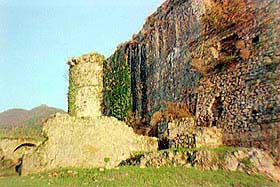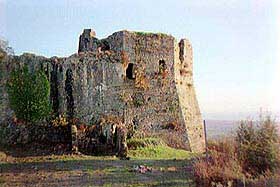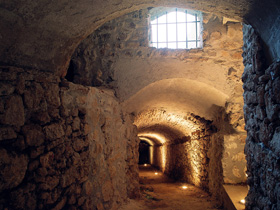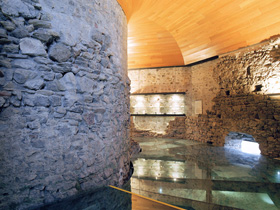Aghinolfo Castle
 |
 |
Left: The curtain of connection between the
keep and the round tower of Southwest. |
The castle of Aghinolfo rises above the country of Montignoso, around three kilometers south from the center of the city of Massa in the northwest of Tuscany.
» Where is Aghinolfo Castle
located
» Click here for more Photos
»
Photos of the restored keep [2002]
» Download Official Brochure (Italian only)
 Montignoso is one of the smallest communes
of Lunigiana (the name of this part of Tuscany), but has always played
an important part in history. This is thanks to its position
on top of a hill from
which it dominates the valley below which is crossed by a stream. Its
position also allows it control the Tyrrhenian coast which is only four
kilometers away.
Montignoso is one of the smallest communes
of Lunigiana (the name of this part of Tuscany), but has always played
an important part in history. This is thanks to its position
on top of a hill from
which it dominates the valley below which is crossed by a stream. Its
position also allows it control the Tyrrhenian coast which is only four
kilometers away.
The Castle is first mentioned in documents of
the year 753 A.D., when the Longobard king Astolfo made gift to one of his brother-in-law, the abbot founder of the abbey
of Nonantola near Modena, of a piece of land in this area. From
the name 'Aghinolfo' came out the clear Longobard origin of the
castle,
even if it's not sure that its foundation was been effected by the King
in person or by a vassal of him, while it's certain that the zone of
Montignoso belonged at that times to the crown.
Certainly the castle was the most powerful of the valley and shelter
for all the populations of the zone in case of danger. Clearly traces
of the fortification of that time haven't yet remained, having it been
reconstructed many times in the following centuries.
The descendants of Aghinolfo remained in possession of the castle up to year 1376; subsequently the fortification passed to the city of Lucca, that provide the reparations and necessary improvements, for making it a strong outpost against the gangs formed by the soldiers of fortune and the various Republic enemies that infested the area, were performed.
 Thanks to the writings of Giovanni Sforza, historian
of last century, we have an exact description of the aspect
of the castle in 1494, when it was given to Charles VIII king of France.
On the fortification rose two tall towers, calls one 'tower
of S.Francesco' and the other 'of S.Paolino', and the walled area was extended for around
an hectare. This area was divided in three fortified enclosures.
Thanks to the writings of Giovanni Sforza, historian
of last century, we have an exact description of the aspect
of the castle in 1494, when it was given to Charles VIII king of France.
On the fortification rose two tall towers, calls one 'tower
of S.Francesco' and the other 'of S.Paolino', and the walled area was extended for around
an hectare. This area was divided in three fortified enclosures.
In the first ward were 43 buildings, used as refuge
by the inhabitants of Montignoso during the periods of war or as storehouses
in time of peace. In the second enclosure, that was accessed through
a drawbridge, there were other 87 houses while in
the third and last,
on the top of the hill, rose up the core of the fortification.
This was constituted from a big octagonal tower, the
'Mastio' or keep,
connected to a round tower by a stone curtains. Between
the endowments of the castle there were a big cistern that
collects rainwater and provided water supply for the fortress, a chapel, a
mill and a secret
passage that brought
outside from the tower.
It doesn't result that the mighty fortification
has been ever conquered, but the lack of works of maintenance and the years
of abandon have reduced it in a ruinous state.
In the 16th century the malaria struck harshly
the zone and caused a strong decrease of the population, but the
castle suffered the hardest damages from the 1799 when, after
it was abandoned by the Lucchesi in consequence of the Giacobine invasion,
the inhabitants began
to steal the wood of the beams, of the doors and windows, the stones and the
bricks of the curtain walls to use them in their own houses.
Some time after the new Lord of Lucca, Carlo
Ludovico di Borbone, bought
the castle with the intention to restructure it, but this remained only
an intention ever put in work. Today we are still able to admire the
mighty ruins on which fortunately from the autumn of 1998 started
an important work of restorations.

View from the top of the keep, after the restoration.
 On
April 1, 2001 the castle was finally returned to the local community
and visitors after a long restoration carried on by the Municipality
of Montignoso with a project entrusted to the architects Nicola Gallo,
Antonio Silvestri
and
Andrea
Tenerini.
Inside, a glass floor showing the stratigraphy of the
original flooring and some ancient objects found there. For the occasion
inside the restored
keep was also made a multimedia permanent
installation that explains the development
stages of the castle with animated reconstructions.
On
April 1, 2001 the castle was finally returned to the local community
and visitors after a long restoration carried on by the Municipality
of Montignoso with a project entrusted to the architects Nicola Gallo,
Antonio Silvestri
and
Andrea
Tenerini.
Inside, a glass floor showing the stratigraphy of the
original flooring and some ancient objects found there. For the occasion
inside the restored
keep was also made a multimedia permanent
installation that explains the development
stages of the castle with animated reconstructions.
In 2008, also the last restoration work was finished, making possible to access the 'archaeological park' built inside the outer walls of the castle.
Visits at Castello Aghinolfi - Montignoso:
from 1 October 2010 to April 1, 2011:
Sundays and holidays: 15.00 / 17.30 (ticket office closes at 17.00)
More Photos
|
Back to Homepage
|
Back to Castles
Index
|